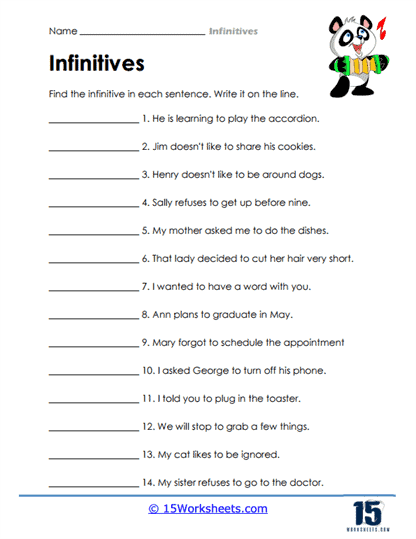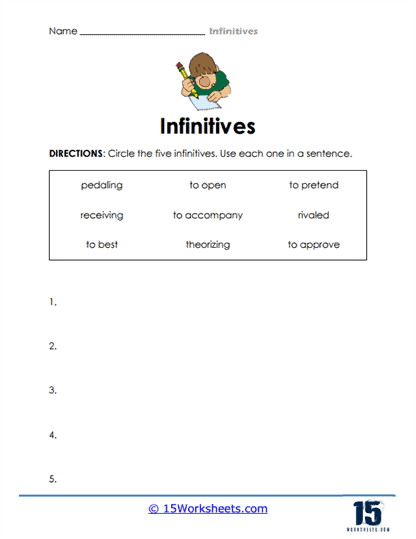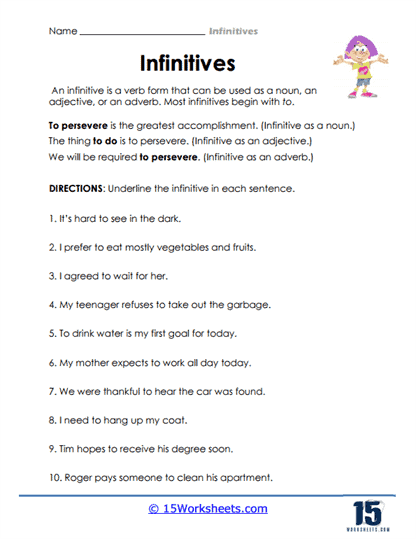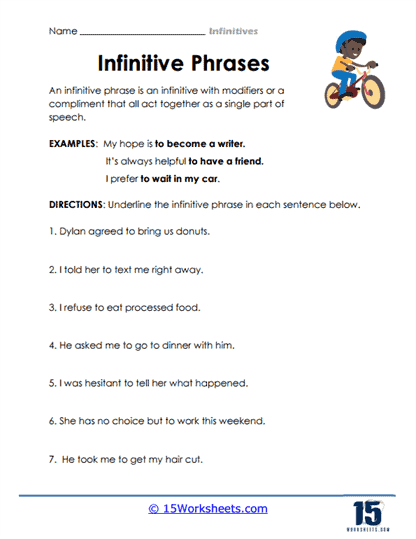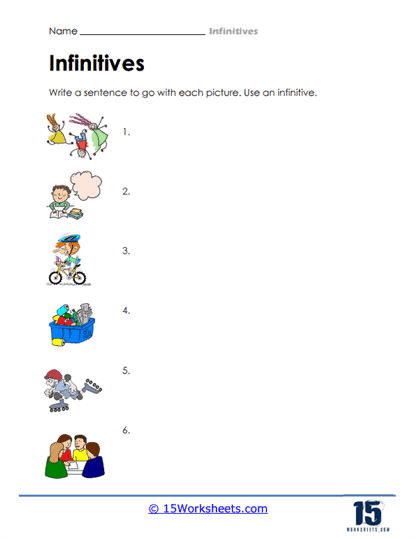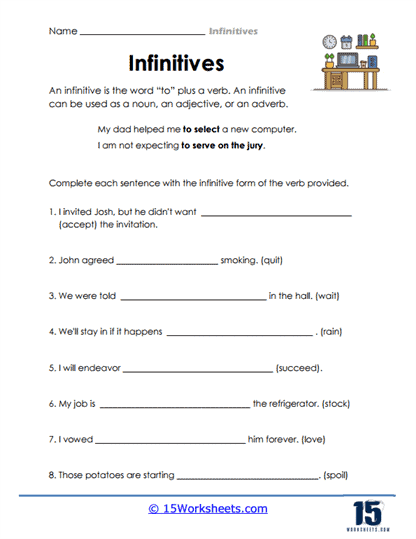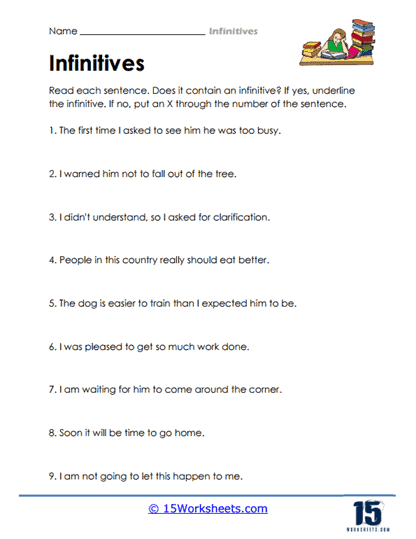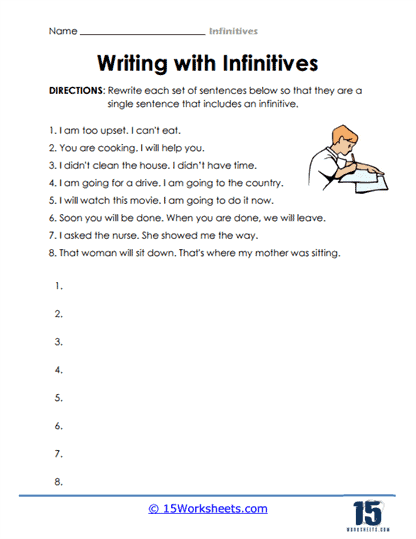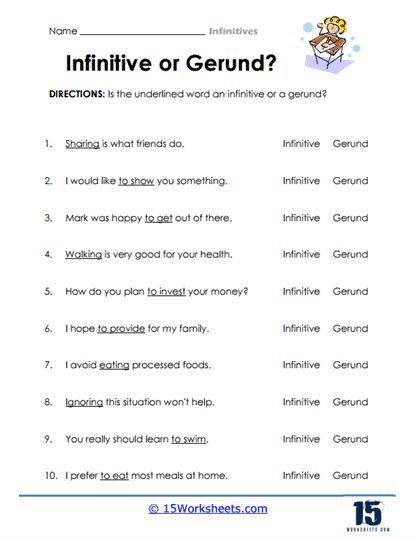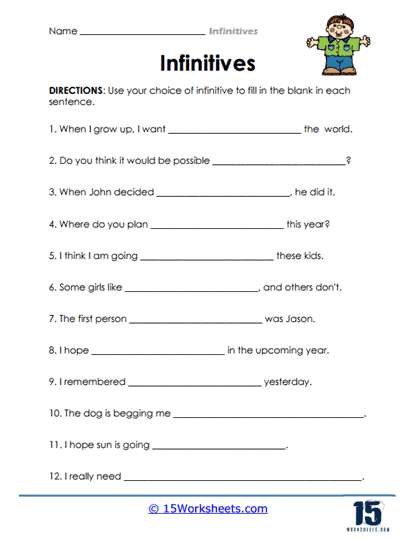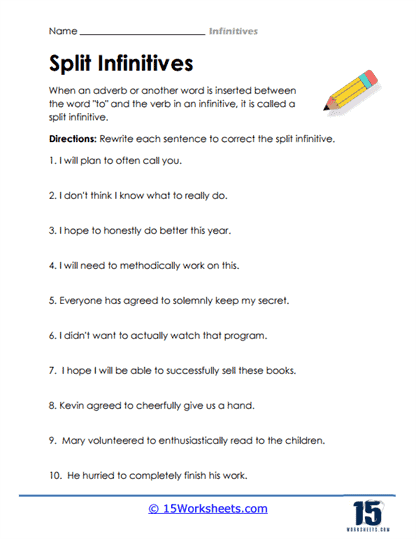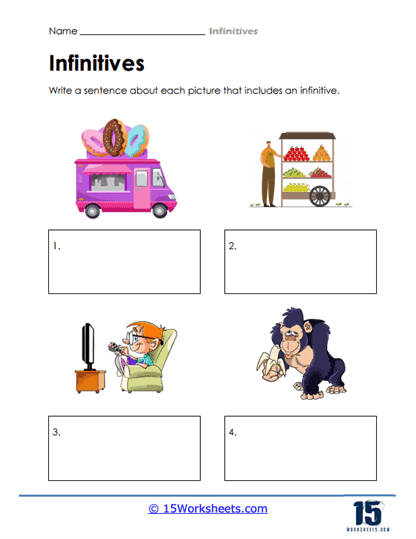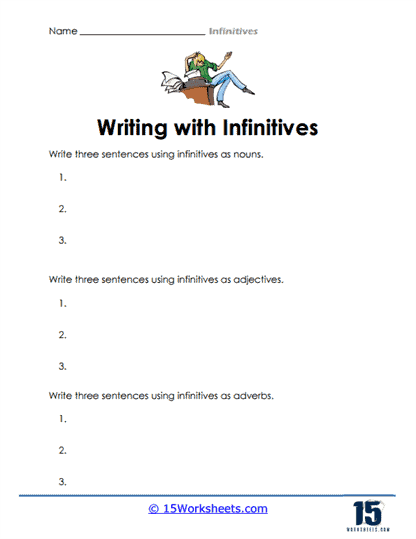Infinitives Worksheets
All About These 15 Worksheets
These Infinitives worksheets are a great way to help students learn about infinitives. A few worksheets in this collection are ideal for teachers who wish to introduce the topic to their students, as they begin with a brief explanation of what infinitives are, including their structure and how they are used in sentences. The other worksheets can be given to students who have further mastery on the use of infinitives. Through these worksheets, students will:
- Understand and identify how infinitives can be used as a noun, an adjective, or an adverb;
- Create their own sentences using infinitives correctly;
- Complete sentences by supplying the correct form of its infinitive;
- Combine pairs of sentences using infinitives;
- Distinguish infinitives from gerunds;
- And rewrite sentences to correct their split infinitives.
Overall, these worksheets are a comprehensive and engaging resource that teachers can give to their students so they can understand and master the use of infinitives in English.
What are Infinitives and why do they matter?
Infinitives are verb forms that are often used with the word “to” and can function as a noun, an adjective, or an adverb in a sentence. They are an essential component of English grammar and play an important role in sentence construction and communication. Infinitives matter for several reasons:
- They help us express our intentions and desires. Infinitives are often used to express what someone wants or intends to do, such as “I want to learn Spanish” or “He hopes to travel the world.”
- They enable us to describe actions. Infinitives can be used to describe actions in a general or abstract sense, such as “to run” or “to swim.”
- They make our writing more concise. By using an infinitive, we can convey an action in just one word, which can help make our writing more efficient and streamlined.
- They add variety and nuance to our language. Infinitives can be used in a wide variety of ways, from expressing conditional statements (“If I were to win the lottery, I would buy a yacht”) to giving advice (“To be successful in life, you must work hard”). This versatility allows us to express ourselves in more nuanced and interesting ways.
In short, infinitives are an essential part of the English language and are used in a wide variety of contexts, making them an important concept for students of English to understand and master.
How to distinguish Infinitives from Gerunds
Infinitives and gerunds are both verb forms that end in “-ing” and can sometimes be confused with each other. However, there are some key differences between them that can help you distinguish one from the other:
- Structure – Infinitives are preceded by the word “to,” while gerunds are not. For example, “to eat” is an infinitive, while “eating” is a gerund.
- Function – Infinitives can function as nouns, adjectives, or adverbs in a sentence, while gerunds always function as nouns. For example, in the sentence “I like to read,” the infinitive “to read” functions as a direct object, while in the sentence “Reading is fun,” the gerund “reading” functions as the subject.
- Prepositions – Infinitives are often preceded by the preposition “for” or “to,” while gerunds are often preceded by other prepositions such as “by,” “with,” or “without.” For example, “I went to the store to buy some milk” (infinitive) versus “I lost weight by running every day” (gerund).
- Verbs – Infinitives are often used after certain verbs such as “want,” “need,” or “like,” while gerunds are often used after certain verbs such as “enjoy,” “hate,” or “admit.” For example, “I want to eat pizza” (infinitive) versus “I enjoy eating pizza” (gerund).
In summary, while both infinitives and gerunds share some similarities, such as ending in “-ing,” they differ in their structure, function, preposition usage, and verb usage. Knowing these differences can help you distinguish one from the other in a sentence.
What are Split Infinitives and how to correct them
A split infinitive occurs when an adverb is placed between the word “to” and the verb in an infinitive phrase, such as in the sentence “to boldly go.” Split infinitives were once considered grammatically incorrect in English, but they are now widely accepted and used in modern English.
However, in some formal writing or academic contexts, it may still be preferred to avoid split infinitives. If you want to correct a split infinitive, there are a few ways to do so:
- Move the adverb. One way to correct a split infinitive is to move the adverb to a different position in the sentence. For example, instead of saying “to quickly run,” you could say “to run quickly.”
- Use a different adverb. Instead of using an adverb that splits the infinitive, you could use a different adverb that does not. For example, instead of saying “to easily understand,” you could say “to understand easily.”
- Rewrite the sentence. If neither of the above options work, you may need to rewrite the sentence entirely to avoid the split infinitive. For example, instead of saying “to really improve,” you could say “to improve greatly.”
In general, it is not always necessary to correct split infinitives, as they are widely used and accepted in modern English. However, if you are writing in a formal or academic context and want to avoid split infinitives, these strategies can help you do so while still expressing your intended meaning.



